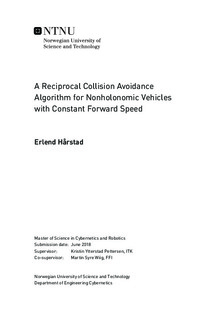A Reciprocal Collision Avoidance Algorithm for Nonholonomic Vehicles with Constant Forward Speed
Master thesis
Permanent lenke
http://hdl.handle.net/11250/2559721Utgivelsesdato
2018Metadata
Vis full innførselSamlinger
Sammendrag
There have been an increased interest in autonomous vehicles in recent years following advancements in technology. Such advanced systems requires robust and reliable Collision Avoidance (CA) systems. Reactive Collision Avoidance (RCA) algorithms assume that there is no central coordinator or direct communication between vehicles and only requires local sensor data which can be obtained from on-board sensors.Many vehicles such as cars and ships are limited by nonholonomic constraints i.e. they can move forward and turn, but not move sideways. Large ships also have a limited speed envelope and significant constraints on their forward speed due to high mass.This thesis presents an reciprocal CA algorithm for nonholonomic vehicles with constant speed. The algorithm uses the concept of Collision Cone (CC) to detect possible collisions. The focus remains on vessels at sea and the algorithm is designed such that the CA maneuver is carries out in a predictable and safe manner by respecting the international regulations for preventing collisions at sea, also known as COLREGS. The algorithm considers the reactive nature of other vessels and is designed so that vehicles share the responsibility of avoiding a collision between them in a fair way. Issues such as reciprocal dances and deadlocks are common for reciprocal CA algorithms. The proposed algorithm is designed to minimize the occurrence of such effects. Simulations illustrating how the algorithm respect the COLREGS are given and the performance of the algorithm have been extensively tested and verified through Monte Carlo simulations. Strengths and weaknesses of the algorithm are identified and suggestions for improvements are given.
